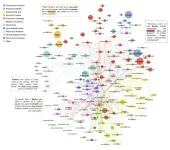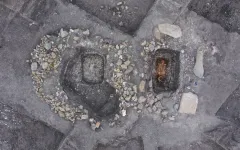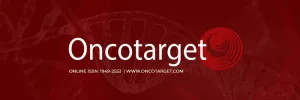(Press-News.org) A team of researchers has developed a machine learning model that draws from the contents of news articles to effectively predict locations that face risks of food insecurity. The model, which could be used to help prioritize the allocation of emergency food assistance across vulnerable regions, marks an improvement over existing measurements.
“Our approach could drastically improve the prediction of food crisis outbreaks up to 12 months ahead of time using both real-time news streams and a predictive model that is simple to interpret,” says Samuel Fraiberger, a visiting researcher at New York University’s Courant Institute of Mathematical Sciences, a data scientist at the World Bank, and an author of the study, which appears in the journal Science Advances.
“Traditional measurements of food insecurity risk factors, such as conflict severity indices or changes in food prices, are often incomplete, delayed, or outdated,” adds Lakshminarayanan Subramanian, a professor at the Courant Institute and one of the paper’s authors. “Our approach takes advantage of the fact that risk factors triggering a food crisis are mentioned in the news prior to being observable with traditional measurements.”
Food insecurity threatens the lives of hundreds of millions of people around the world. According to the Food and Agriculture Organization of the United Nations, the number of undernourished increased from 624 million people in 2014 to 688 million in 2019. Conditions, the paper’s authors note, have deteriorated since then due to the Covid-19 pandemic, climate change, and armed conflicts—in 2021, between 702 and 828 million people worldwide faced hunger. Moreover, severe food insecurity increased both globally and in every region in 2021.
Despite the acute and widespread nature of this affliction, current methods to detect future food crises rely on risk measures that are insufficient, hindering efforts to address them.
In working to develop a better model, the paper’s authors, who also included Ananth Balashankar, a Courant doctoral graduate, considered the possibility that news coverage, which offers real-time, on-the-ground accounts of local developments, could serve as an early-warning system for impending food crises.
The researchers collected text from more than 11 million news articles focused on nearly 40 food-insecure countries that were published between 1980 and 2020. They then developed a method to extract particular phrases in these articles related to food insecurity and in ways that capture journalistic assessment in notable detail. Specifically, the tool accounts for nearly 170 text features in order to correctly gauge the semantics of the phrases pertaining to food insecurity and to mark when the articles appear. The following is an example from South Sudan, which outlines both location and risk factors: “Famine may return to some parts of the country, with eastern Pibor county, where floods and pests have ravaged crops, at particular risk.”
They then considered data on a range of food-insecurity risk factors—such as conflict fatality counts, rainfall, vegetation, and changes in food prices—to determine if there was correlation between news mentions of these factors and their occurrence in the studied countries and regions. Here, they found a high correlation between the nature of the coverage and the on-the-ground occurrences of these factors, indicating that news stories are an accurate indicator of the studied conditions.
But to determine if news articles were, in fact, a good predictor of subsequent food crises, the team needed to know if the nature of the coverage was a viable indicator of future crises and if these stories did so more accurately than traditional measurements. Using a smaller set of news stories, the researchers found that from 2009 to 2020 and across 21 food-insecure countries, news coverage yielded more accurate predictions at the local level of food insecurity—and did so up to 12 months ahead of time—than traditional measurements that did not include news story text. Notably, they also found that supplementing traditional predictive measures with news coverage further improved the accuracy of food-crisis predictions, suggesting the value of “hybrid” models.
The researchers also see potential larger uses for their work.
“News indicators could be extended to the prediction of disease outbreaks and the future impact of climate change,” observes Balashankar.
An image depicting the work is available on Google Drive.
DOI: 10.1126/sciadv.abm3449
# # #
END
News you can use—to better predict food crisis outbreaks
Machine-learning model analyzes articles’ content and frequency to make precise predictions on where next hunger scourge will occur
2023-03-03
ELSE PRESS RELEASES FROM THIS DATE:
Tumour cells’ response to chemotherapy is driven by randomness
2023-03-03
Cancer cells have an innate randomness in their ability to respond to chemotherapy, which is another tool in their arsenal of resisting treatment, new research led by the Garvan Institute of Medical Research shows.
Understanding why some tumour cells become resistant to chemotherapy is a core challenge in cancer research, as chemotherapy is still a frontline treatment for most cancers.
The new research shows that tumour cells from neuroblastoma – cancer that develops in the body’s ‘fight or flight’ sympathetic nervous system – can move between states of responding, or not, to chemotherapy.
“We showed there is ‘noise’ in the process of cell ...
On social media platforms, more sharing means less caring about accuracy
2023-03-03
As a social media user, you can be eager to share content. You can also try to judge whether it is true or not. But for many people it is difficult to prioritize both these things at once.
That’s the conclusion of a new experiment led by MIT scholars, which finds that even considering whether or not to share news items on social media reduces people’s ability to tell truths from falsehoods.
The study involved asking people to assess whether various news headlines were accurate. But if participants were first asked whether they would share that content, they were 35 percent worse at telling truths from ...
The world’s first horse riders
2023-03-03
The researchers discovered evidence of horse riding by studying the remains of human skeletons found in burial mounds called kurgans, which were between 4500-5000 years old. The earthen burial mounds belonged to the Yamnaya culture. The Yamnayans had migrated from the Pontic-Caspian steppes to find greener pastures in today´s countries of Romania and Bulgaria up to Hungary and Serbia.
Yamnayans were mobile cattle and sheep herders, now believed to be on horseback.
“Horseback-riding seems to have evolved not long ...
Detecting anaemia earlier in children using a smartphone
2023-03-03
Researchers at UCL and University of Ghana have successfully predicted whether children have anaemia using only a set of smartphone images.
The study, published in PLOS ONE, brought together researchers and clinicians at UCL Engineering, UCLH and Korle Bu Teaching Hospital, Ghana to investigate a new non-invasive diagnostic technique using smartphone photographs of the eye and face.
The advance could make anaemia screening more widely available for children in Ghana (and other low- and middle-income countries) where ...
Israel: the origin of the world's grapevines
2023-03-03
A recent study on the genetic makeup of grapevine has revealed fascinating insights into its domestication and evolution. The study, published in the journal Science, suggests that the harsh climate during the Pleistocene era resulted in the fragmentation of wild ecotypes, which paved the way for the domestication of grapevine about 11,000 years ago in the Near East (Israel) and the Caucasus.
The research team sequenced the genomes of 3525 grapevine accessions (2503 V. vinifera (domesticated) and 1022 V. sylvestris (wild) accessions of grapevine, to identify the genetic changes that occurred during domestication and evolution of grapevine in Euro-Asia.
According to the study, ...
IPK researchers provide insights into grain number determination mechanism of barley
2023-03-03
Modifying inflorescences with higher grain capacity is vital for crop grain production. One recurring target is to select inflorescences with more branches or floral structures. Prominent examples include genes affecting floral identity or meristem determinacy, for which natural or induced variants profoundly change floral primordium number. Yet for temperate cereal crops, such as wheat and barley, excessive floral structures can result in a degeneration penalty due to the indeterminate nature of meristems. On the other hand, the manifestation of this reproductive potential can be accentuated by environmental ...
Pitt and UCI researchers receive grant to understand patient reactions to Alzheimer's disease diagnoses
2023-03-03
University of Pittsburgh and University of California, Irvine (UCI) researchers have received funding from the National Institute of Aging to advance understanding of real-world patient and family member reactions to biomarker-informed Alzheimer’s disease and related disorders diagnoses.
The grant, which is expected to total $3.5 million over up to five years, will enable researchers to better understand the experiences and potential psychological impact of receiving Alzheimer’s biomarker results. These findings will provide important information for supporting patients and their families and inform best practices in the rapidly evolving state-of-the-art diagnostic ...
Oncotarget | Unveiling the non-canonical functions of EZH2 in prostate cancer
2023-03-03
“In summary, both articles by Yi et al. emphasized the significance of non-canonical functions of EZH2 during PCa [prostate cancer] development [...]”
BUFFALO, NY- March 3, 2023 – A new editorial paper was published in Oncotarget's Volume 14 on February 11, 2023, entitled, “Unveiling the non-canonical functions of EZH2 in prostate cancer.”
Prostate cancer (PCa) is ranked as the second leading cause of cancer-related death among American men excluding skin cancer. ...
Adding antipsychotic med to antidepressant may help older adults with treatment-resistant depression
2023-03-03
For older adults with clinical depression that has not responded to standard treatments, adding the drug aripiprazole (brand name Abilify) to an antidepressant they’re already taking is more effective than switching from one antidepressant to another, according to a new multicenter study led by Washington University School of Medicine in St. Louis.
Aripiprazole originally was approved by the FDA in 2002 as a treatment for schizophrenia but also has been used in lower doses as an add-on treatment for clinical depression ...
American Foregut Society white paper recommends expanding endoscopic classification of esophogastric junction integrity beyond hill grade
2023-03-03
A new white paper by the American Foregut Society recommends expanding the classification of the esophagogastric junction (EGJ) to increase an assessment of the axial hiatal hernia length, hiatal hernia aperture diameter, and presence or absence of the flap value making it more comprehensive. The white paper is published in the December issue of Foregut, the only subscription journal focused exclusively on foregut disease linking medical, endoscopic, and surgical disciplines.
Gastrointestinal reflux disease ...
LAST 30 PRESS RELEASES:
Interaction of climate change and human activity and its impact on plant diversity in Qinghai-Tibet plateau
From addressing uncertainty to national strategy: an interpretation of Professor Lim Siong Guan’s views
Clinical trials on AI language model use in digestive healthcare
Scientists improve robotic visual–inertial trajectory localization accuracy using cross-modal interaction and selection techniques
Correlation between cancer cachexia and immune-related adverse events in HCC
Human adipose tissue: a new source for functional organoids
Metro lines double as freight highways during off-peak hours, Beijing study shows
Biomedical functions and applications of nanomaterials in tumor diagnosis and treatment: perspectives from ophthalmic oncology
3D imaging unveils how passivation improves perovskite solar cell performance
Enriching framework Al sites in 8-membered rings of Cu-SSZ-39 zeolite to enhance low-temperature ammonia selective catalytic reduction performance
AI-powered RNA drug development: a new frontier in therapeutics
Decoupling the HOR enhancement on PtRu: Dynamically matching interfacial water to reaction coordinates
Sulfur isn’t poisonous when it synergistically acts with phosphine in olefins hydroformylation
URI researchers uncover molecular mechanisms behind speciation in corals
Chitin based carbon aerogel offers a cleaner way to store thermal energy
Tracing hidden sources of nitrate pollution in rapidly changing rural urban landscapes
Viruses on plastic pollution may quietly accelerate the spread of antibiotic resistance
Three UH Rainbow Babies & Children’s faculty elected to prestigious American Pediatric Society
Tunnel resilience models unveiled to aid post-earthquake recovery
Satellite communication systems: the future of 5G/6G connectivity
Space computing power networks: a new frontier for satellite technologies
Experiments advance potential of protein that makes hydrogen sulfide as a therapeutic target for Alzheimer’s disease
Examining private equity’s role in fertility care
Current Molecular Pharmacology achieves a landmark: real-time CiteScore advances to 7.2
Skeletal muscle epigenetic clocks developed using postmortem tissue from an Asian population
Estimating unemployment rates with social media data
Climate policies can backfire by eroding “green” values, study finds
Too much screen time too soon? A*STAR study links infant screen exposure to brain changes and teen anxiety
Global psychiatry mourns Professor Dan Stein, visionary who transformed mental health science across Africa and beyond
KIST develops eco-friendly palladium recovery technology to safeguard resource security
[Press-News.org] News you can use—to better predict food crisis outbreaksMachine-learning model analyzes articles’ content and frequency to make precise predictions on where next hunger scourge will occur







